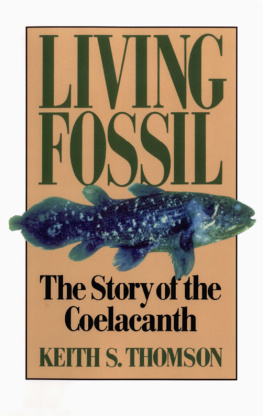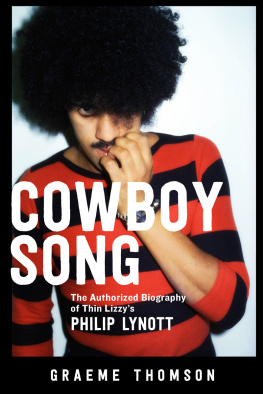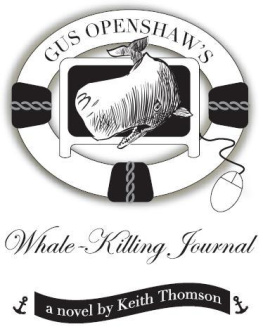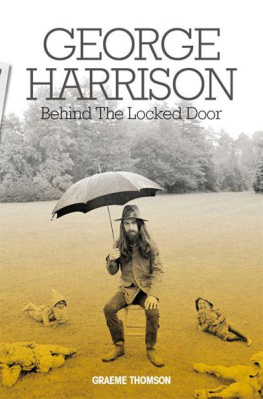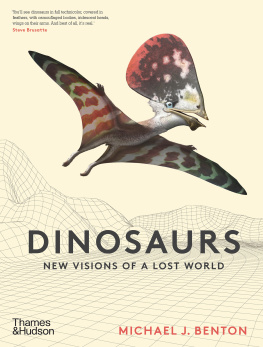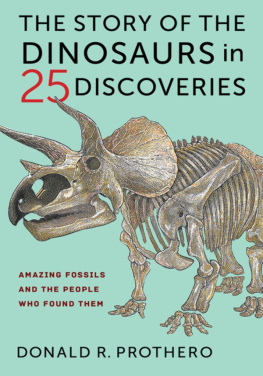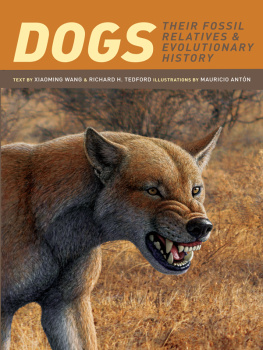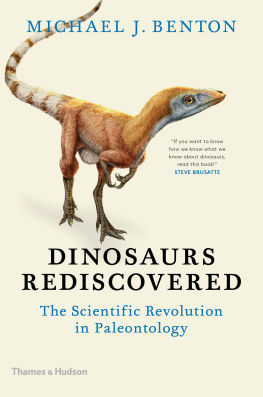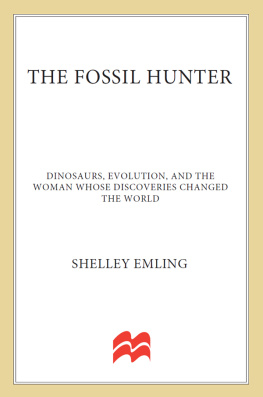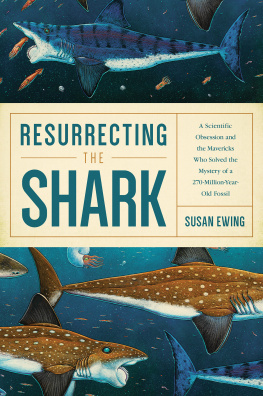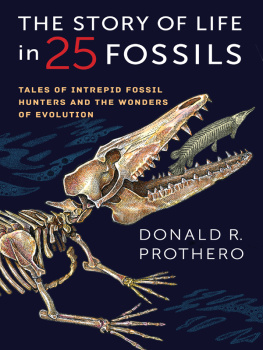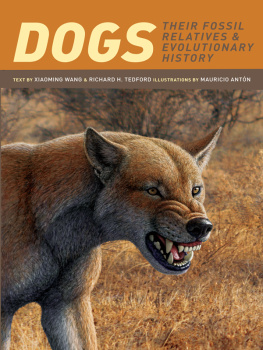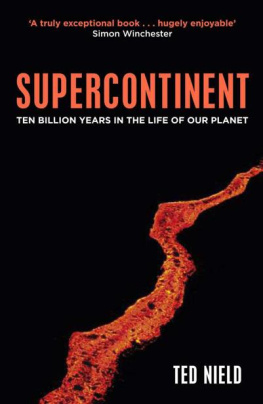LIVING FOSSIL

Contents
Ex Africa semper aliquid novi.
There is always something new out of Africa.
Pliny the Elder

T his is, simply enough, a book about a fish. But nothing interesting is ever really simple. Very soon after I became interested in the living fossil fish Latimeria chalumnae, better known as the coelacanth, I realized that I was studying a legend as well as an animal. As the years moved by, I have grown fascinated as much by the stories of the people associated with this fish as by the scientific results of their labors. The romance of discovery after its group was thought to have been extinct for eighty million years, and the fact of its possible relationship to higher vertebrates including man, have given this big ugly fish a sort of star quality.
The story of the coelacanth, perhaps the most famous species of fish in the world, has been told before, from its first discovery off South Africa in December 1938 to the latest revelations from the Comoro Islands. Some of the old stories have now been embroidered with a rich weave of invention, and new stories arise, ever more fanciful: The oil from coelacanth flesh has aphrodisiac properties; the oil causes liver cancer; the fish really lives in freshwater springs under the ocean; it is the direct ancestor of all land vertebrates (including man); it is a sort of shark; it also lives in the Mediterranean and/or the Red Sea. Some of these myths have been lost and then rediscovered (roughly at ten-year intervals). Music has been written about the coelacanth, and Ogden Nash once wrote a poem in its praise. The fish has been the subject of countless cartoons. Not a few otherwise sober scientists have floated into flights of embarrassing fancy by old fourlegs, as J. L. B. Smith so inappropriately named it. And there are more self-appointed experts on the coelacanth than there are specimens.
In the rush to cash in on the rarity of the coelacanth, enterprising types have purchased specimens from the Comores and attempted to sell them at a large profit to museums around the world. Cashing in on the glamour, institutions have sent expeditions to the Comores to catch live specimens and have counted it a great success (at least for the press) to come back with a preserved specimen purchased from the government. Not surprisingly, others have fabricated accounts of mysterious captures or sightings of the fish and sold their stories to the press.
Up to now the remoteness of its island base and the rarity of capture of specimens have seemed to assure the survival of the species. In fact, no one, other than Comoro islanders and the trawler captain who snared the first one, has ever caught a coelacanth. Several Western expeditions equipped with the latest fancy gear have tried and failed. But now there is every reason to fear that the very attraction of the coelacanth will cause its extinction. Too many specimens are being caught by the islanders for sale overseas, either officially or on the black market. And now that the technology exists to go after the fish underwater, attempts to capture live specimens for exhibit (for enormous potential financial reward) are inevitable.
In this book I attempt to retell the story of the living coelacanth and its relatives and thereby to unravel some of the mysteries concerning its biology: How does it live? Indeed, where does it live? How does it reproduce? How has it managed to avoid extinction over the last eighty million years? And what are its chances now? The story of the coelacanth is also the story of a large number of fascinating people, many of whose names will never be recorded. It is a story of careful planning and blind luck, of human determination and certainly of human foibles, where experience is more useful than a hundred-thousand-dollar machine. In other words, it is not a Hollywood version of science, full of white-coated saintliness and brilliantly executed experiment, but it is pretty much a story of what science (good and bad science) is really like, especially when it involves biologists getting out in the field, soaking wet. When one strips away all the mythology and all the media hype, the coelacanth is simply a fish, a very large, prickly-scaled, oily, sluggish, but sharp-toothed fish that, when dead, is particularly smelly. It lives in the sea as men do a-land; the great ones eat up the little ones, as Shakespeare said.
In researching this book I have been surprised by a number of inconsistencies. In addition to the usual errors and sheer laziness of science journalism, even different versions of accounts by some participants have been inconsistent. Eyewitnesses of events have adjusted their versions over the years. Information claimed as firsthand has turned out to be secondhand after all, and usually elaborated in the transfer; a romantic overlay has been applied, especially to the role of Professor Smith; a dramatic march through the mountains turns out to have been a ride in a truck, for example. My greatest fear is that while I might clarify much of the story, the fact that we all are forced to rely on a few basic sources means that errors remain and may even have been reinforced here.
Finally, events always move quickly with respect to the coelacanth. At the time of writing (early 1990) the Comoro Islands are in political upheaval once again; a new group of players has taken center stage in the scientific dramanamely, a well-supported Japanese research team that is hard at work trying to capture a live specimen.
I am indebted to a great number of friends and colleagues for their encouragement and assistance over the years in this and other projects, in particular the late A. S. Romer, Robert Griffith, James Atz, Robert Giegenbach, C. L. Smith, Bobb Schaeffer, Humphrey Greenwood, Colin Patterson, Peter Forey, John Maisey, Robert Mc. Peck, and all my students at Yale. Dr. Atz gave me access to his marvelous collection of cuttings and articles on the coelacanth, including his copy of Smiths poster, and also arranged with the American Museum of Natural History for use of two of the photographs reproduced here. Dr. M. Bruton of the J. L. B. Smith Institute in South Africa was of great assistance in obtaining copies of important photographs in its collection pertaining to the first two captures of coelacanths. Michelle Press, managing editor of American Scientist magazine, kindly agreed to the use of materials that had previously been published in two articles by me in American Scientist in 1986 and 1989. Mrs. Maureen Joubert, librarian at the South African Embassy in Washington, was extremely helpful with South African geography and biography. Dr. Richard Greenwell allowed me use of two of his photographs, and the whole community should be grateful to him for his sensitive interviews with Miss Courtenay-Latimer and Mr. Goosen in South Africa.
Bob Griffith and Jim Atz also generously read the entire manuscript, correcting as many errors as their patience could bear and improving the scientific treatment in innumerable ways.
The staffs of the Free Library of Philadelphia, Yale University Library, and the Boston Public Library have helped me greatly, and I owe a great debt in particular to the entire staff of the Library of the Academy of Natural Sciences. I1 am grateful to my indefatigable administrative assistant, Sheryl Harris, for her patience, to Jessica Thomson for help with library research, and, as always, to Linda Price Thomson for all the drawings. A lot of my work on living and fossil fishes has been supported by the National Science Foundation, whose role in maintaining a balanced spectrum of science support is rarely completely appreciated.

